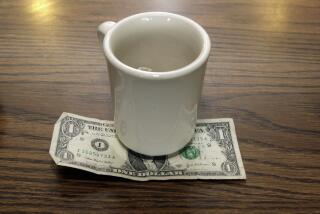Biggest Restaurant Tips: Now, That’s Italian
WASHINGTON — Waiters in Italian restaurants in America get the biggest tips from customers while those in Mexican eateries fare the worst, the Internal Revenue Service has found.
The average tip in Italian restaurants in 1986 was 15.8%, compared with 15% in Chinese restaurants and 14.8% in Mexican restaurants, according to an IRS study.
On the other hand, patrons in Chinese restaurants were more likely to leave a tip--90 out of every 100 did--than in Italian restaurants, where only 88 saw fit to leave something. In restaurants serving Mexican food there were 86 tips for every 100 customers.
The study did not try to give any reason for the differences, nor did it ask about restaurants that serve the foods of other countries.
At least one waiter at a small Italian restaurant in Georgetown, a popular Washington restaurant area, agreed that he got better tips there than in other places he had worked.
“It’s the European atmosphere,” explained Mouez Zemni, who comes not from Italy but from Tunisia, on the other side of the Mediterranean. “There’s the European flair. People like the atmosphere and it relaxes them. It doesn’t even matter about the food. I don’t like Italian food much myself--I think French food is much better.”
At a bigger, pricier Italian place, the maitre d’ was not so sure about high tips. “Some people come in here with a couple of kids and leave a dollar,” said Julio Estrada. “About 20%-25% don’t leave anything.”
A waiter at a Mexican restaurant would not agree that his tips were inferior. “It’s a matter of food and service,” he insisted, a little stiffly. “If a customer gets good food and good service, he tips well.”
What started the IRS investigation is that waiters are required by law to include tips in their earnings and pay income tax on them.
“Underreporting of tip income has long been a concern,” Thomas A. Thompson, an IRS researcher, wrote in his report on the situation.
So the service hired the Survey Research Laboratory of the University of Illinois to query its panel of nearly 13,000 households, both families and individuals. They kept records of their tips over two-week periods between 1983 and 1986.
“The diary approach used in this study was adopted on the ground that tipping information obtained from people leaving tips is likely to be more accurate than data obtained from tip recipients,” Thompson said.
Before narrowing the survey down to ethnic restaurants, the study tried other classifications, with labels that included “family-type restaurants” and “atmosphere-specialty restaurants.” That turned out to be too vague.
People tipped more in restaurants that accepted credit cards and those that served alcohol. Patronage at what the report called “tip-type” restaurants declined between 1983 and 1986, but tipping stayed level.
More to Read
Inside the business of entertainment
The Wide Shot brings you news, analysis and insights on everything from streaming wars to production — and what it all means for the future.
You may occasionally receive promotional content from the Los Angeles Times.









